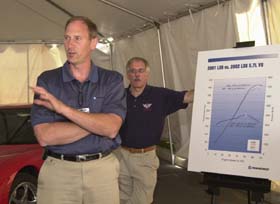| Ruthless Pursuit of Power: The Sequel |
Page3 |
||||
|
LS6 Revolution: Pups Out, New Cats In The key enabler for the cam and everything else to work to the tune of 20 more horsepower was a revolutionary, new catalytic converter design.
"In 2000," John Juriga added, "we had to meet the LEV standard here in California, so we added close-coupled convertors up front (of the regular cats) on the California package–our "pups" as we call ’em. In 2001 we carried those pups across-the-board, including on the LS6. Even while we were implementing that, we were working on a design that would eliminate those pups. This reduced back-pressure by two inches of mercury. On its own, that was worth about 5hp. That seems not much but, if you reduce back-pressure by even small amounts; you can make a bigger gain with improvements on the induction side, especially with the cam." Catalytic converters (aka "catalysts" or "cats") must reach and sustain a high interior temperature for the reaction necessary for the conversion of exhaust pollutants to occur. The period between engine start and cat "light-off" is the most difficult time from an exhaust emissions standpoint because the cat isn’t hot enough to work. The Corvette "under-floor" cats were the same from MY97-01. To meet California LEV for MY00, Juriga’s team of engineers at GM Powertrain Division (GMPT) had to make cat light-off happen sooner and the solution for ’00 California cars and all ’01s was to move the catalytic reaction closer to the exhaust heat by adding small, close-coupled, catalytic convertors, or "pup cats", upstream of the under-floors and closer to the exhaust manifold outlets. While the official ratings did not change, ’00 California cars were probably about 5hp short of the ’97s, ’98s and ’99s because of the pups. MY01 had no deficiency because the LS1 was changed in other areas negating the pup’s power loss. Engineers call the interior structure, or "substrate," of a catalytic converter a "brick" because of its characteristic shape. The ’97-’01 under-floor cat used a single brick having a combination of palladium and rhodium as its reactive ingredients. The ’02 under-floor is a two-brick design. The front brick uses palladium and the rear brick uses a platinum-rhodium combination. This new cat, along with changes in PCM calibration, allows the LS6 to meet LEV without pup cats and their exhaust back-pressure. There were other benefits of going pupless, too: less cost and a 5.5lb. weight reduction. Anyone planning to upgrade an ’01 Z06 to ’02 specs is going to have to do more than just change the camshaft and valve train to get the full 20hp increase. They will need to remove their pups and upgrade to the ’02 under-floor cats. If that’s not done, they’ll see only part of the increase. |
|||||
| Induction
and Calibration Upgrades |
|||||
